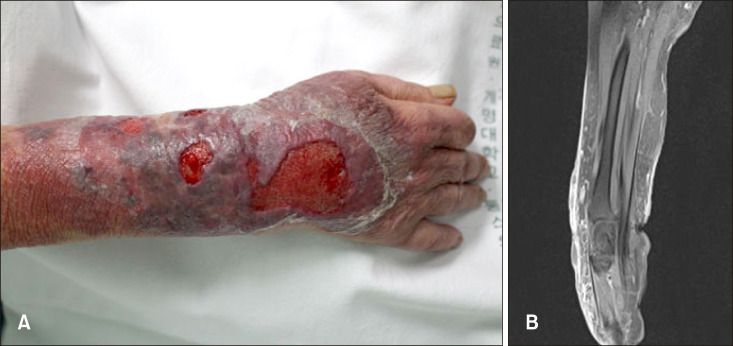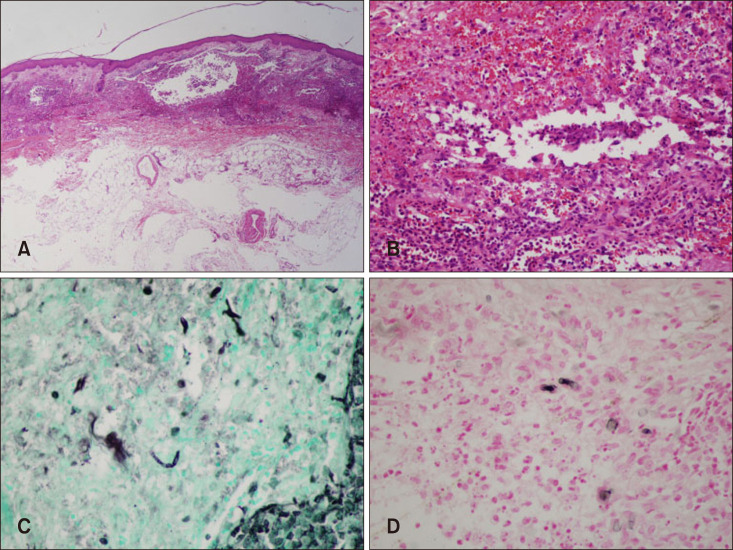Ann Dermatol.
2019 Oct;31(5):563-566. 10.5021/ad.2019.31.5.563.
Unusual Presentation of Subcutaneous Phaeohyphomycosis by Alternaria alternate
- Affiliations
-
- 1Department of Infectious Disease, Keimyung University Dongsan Medical Center, Daegu, Korea. 121rsy@dsmc.or.kr
- KMID: 2456235
- DOI: http://doi.org/10.5021/ad.2019.31.5.563
Abstract
- The Alternaria species are dematiaceous fungi. Human infection due to dematiaceous fungi is uncommon. Most reported cases of alternariosis have occurred in patients with immunodeficiency. The majority of cases were solid-organ transplantation recipients. Cutaneous alternariosis lesions are usually asymptomatic solitary nodules, plaques of ulcers or subcutaneous cysts. Here we report a case of a 77-year-old female who presented with hemorrhagic skin necrosis in right arm that had developed from hemorrhagic bullae. Her prior medical history included iatrogenic Cushing's syndrome, hypertension, interstitial lung disease and congestive heart failure. Following administration of itraconazole, her lesions improved.
Keyword
MeSH Terms
Figure
Reference
-
2. Ajello L, Georg LK, Steigbigel RT, Wang CJ. A case of phaeohyphomycosis caused by a new species of Phialophora. Mycologia. 1974; 66:490–498. PMID: 4601425.
Article3. Kim MS, Kim JK, Lee MW, Moon KC, Kim BJ, Son SW, et al. Epidemiology of deep cutaneous fungal infections in Korea (2006-2010). J Dermatol. 2015; 42:962–966. PMID: 26105506.
Article4. Romano C, Vanzi L, Massi D, Difonzo EM. Subcutaneous alternariosis. Mycoses. 2005; 48:408–412. PMID: 16262877.
Article5. Uenotsuchi T, Moroi Y, Urabe K, Fukagawa S, Tsuji G, Matsuda T, et al. Cutaneous alternariosis with chronic granulomatous disease. Eur J Dermatol. 2005; 15:406–408. PMID: 16172055.6. Magina S, Lisboa C, Santos P, Oliveira G, Lopes J, Rocha M, et al. Cutaneous alternariosis by Alternaria chartarum in a renal transplanted patient. Br J Dermatol. 2000; 142:1261–1262. PMID: 10848774.
Article7. Laumaillé C, Le Gall F, Degeilh B, Guého E, Huerre M. [Cutaneous Alternaria infectoria infection after liver transplantation]. Ann Pathol. 1998; 18:192–194. French. PMID: 9706345.8. Wiest PM, Wiese K, Jacobs MR, Morrissey AB, Abelson TI, Witt W, et al. Alternaria infection in a patient with acquired immunodeficiency syndrome: case report and review of invasive alternaria infections. Rev Infect Dis. 1987; 9:799–803. PMID: 3326127.
Article9. Akman A, Sakalli Cakcak D, Ozhak Baysan B, Yazisiz V, Terzioglu E, Ciftcioglu MA, et al. Cutaneous alternariosis in a patient with systemic lupus erythematosus. Lupus. 2007; 16:993–996. PMID: 18042595.
Article10. Elder DE. Lever's histopathology of the skin. 11th ed. Philadelphia: Lippincott William & Wilkins;2015. p. 739–740.11. Lyke KE, Miller NS, Towne L, Merz WG. A case of cutaneous ulcerative alternariosis: rare association with diabetes mellitus and unusual failure of itraconazole treatment. Clin Infect Dis. 2001; 32:1178–1187. PMID: 11283807.
Article12. Hsiao CT, Lin LJ, Shiao CJ, Hsiao KY, Chen IC. Hemorrhagic bullae are not only skin deep. Am J Emerg Med. 2008; 26:316–319. PMID: 18358943.
Article13. Hsu CC, Chang SS, Lee PC, Chao SC. Cutaneous alternariosis in a renal transplant recipient: a case report and literature review. Asian J Surg. 2015; 38:47–57. PMID: 25554667.
Article14. Sohng SH, Choi JS, Kim YW, Kim BS, Choi JH, Shin DH. A case of cutaneous infection by Alternaria alternata. Korean J Med Mycol. 2014; 19:76–81.15. Acland KM, Hay RJ, Groves R. Cutaneous infection with Alternaria alternata complicating immunosuppression: successful treatment with itraconazole. Br J Dermatol. 1998; 138:354–356. PMID: 9602891.
- Full Text Links
- Actions
-
Cited
- CITED
-
- Close
- Share
- Similar articles
-
- Comments on “Unusual Presentation of Subcutaneous Phaeohyphomycosis by Alternaria alternate” by Lee et al.
- Phaeohyphomycosis Due to Exophiala dermatitidis Successfully Treated with Itraconazole
- A Case of Subcutaneous Phaeohyphomycosis Caused by Exophiala oligosperma Showing Multiple Cysts
- A Case of Primary Subcutaneous Phaeohyphomycosis Caused by Drechslera Dematioidea
- Subcutaneous Mycoses in Korea



